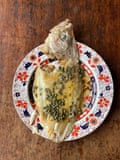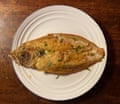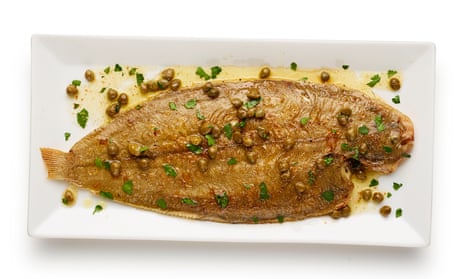Sole meunière “may sound like a fancy French recipe”, but it is, in fact, “an extremely simple dish to cook”, as Frances Bissell admits, relying more on the quality of the ingredients than on any particular culinary skill. It’s also, happily, an excellent way to prepare those under-rated flatfish that have been in the news so much in recent months, the sole “family” (more of them later) being much more extensive than the dover and lemon varieties the British generally deign to acknowledge. Quick, easy and delicious with new potatoes, it’s the ultimate Friday night treat.
The fish

Most of the recipes I try assume the use of a dover sole, but the method works for just about any flatfish (and many other fish, too, though the timings will be different). The megrim, Lepidorhombus whiffiagonis, is actually part of the turbot family, while plaice, lemon and witch soles and dabs are all flounders; the dover is the only true sole found in our waters. Megrims tend to be slightly smaller than dovers, which means they will cook more quickly. Handily, that also means they’re more likely to fit in your pan. If you’re cooking a larger fish, add 30 seconds to a minute on to the cooking times below.
Most recipes call for the fish to be cleaned and the dark skin removed (it’s not pleasant to eat). You could also ask your fishmonger to trim off the head and tail (or do so yourself), but there’s meat in the head so, again, it depends on the size of your pan; they look more impressive served intact, but few of us have something large enough to fry a whole fish in, let alone two.
One of the pleasures of this dish is gently teasing the flesh from the bones, but if you find that process more alarming, you could always, like Rick Stein in his book Fish and Shellfish, carefully fillet it before serving, as they no doubt do in his restaurant. It’s not difficult (watch a video online for tips), but the fish will cool down as you’re doing that, so make especially sure that the butter is nice and hot when you pour it on top.
The coating

Most recipes simply dip the fish in seasoned flour – à la meunière means in the style of the miller, or miller’s wife, if you assume millers are never female and their wives exist only to collect the fruit of their husband’s labour for use in the kitchen – but Bissell’s Modern Classics and Craig Claiborne’s Kitchen Primer both call for it to be bathed in milk first, the latter for “30 minutes or longer”, presumably to neutralise its flavour. Trust me, the megrim does not need such assistance – it’s delicate enough. Nor does the coating need it; in fact, the milk turns a light dusting of flour into something thicker that has a tendency to turn soggy when soaked in butter.
Indeed, X Marcel Boulestin writes in his 1932 collection What Shall We Have Today that “it is, of course, necessary that [the fish] should be quite dry, so, not only do you dry them with a cloth, but also rub them lightly with flour, after which they cook quickly and without sticking to the pan or getting sodden”, but oddly enough, most recipes, with the exception of Lulu Grimes in The Cook’s Book of Everything, fail to touch on this important detail.
Classically, white pepper is used in the seasoning, as much for aesthetics as for its earthier flavour, but go with whichever you prefer; I’m keener on the cleaner heat of the black variety.
The fat

Elizabeth David’s French Provincial Cooking rails against those (me!) who describe this dish as simple to prepare – “simple in conception, certainly, but in execution no”. She accuses us of failing to make it clear that “the butter in which you fry your sole must be clarified butter” and that, once the fish is done, “you should discard the remains of the butter in which your fish was cooked, and … start again with a clean pan and a quantity of fresh butter, not clarified, and … this butter must be brought just exactly to the right point when it turns a pale hazelnut colour, no more and no less”.
Only Grimes and Bissell make any mention of clarified butter – that is to say, butter that has been heated to remove the milky solids, which burn over too high a heat, to leave pure butter fat. Most other recipes use oil alone, as Marcus Wareing recommends in his How to Cook the Perfect book, or a mixture of oil and butter. Oil can be heated to a much higher temperature before it burns, but, like clarified butter, lacks flavour. This isn’t too much of a problem, because the sauce is also made from butter, but some fat will necessarily be absorbed by the flour during the cooking process, and it makes sense for that fat to taste as good as possible. The best solution seems to be to start the fish off in oil or clarified butter, as Tom Aikens and Richard Corrigan suggest, then add the whole butter later on, which also gives it less time to burn.
This means that you may well feel no need to discard this butter and make the sauce from fresh stuff, as David urges; Paul Bocuse doesn’t bother, while Stein and Wareing use a completely clean pan for the purpose. If you’re cooking a lot of fish in succession, this is a good idea, but if you’re doing just a couple (and I do agree with David that, “unless your kitchen is supplied with a suitable pan, it is best not to try and cook sole meunière or similar dishes for more than two people”), you’ll probably get away with using the same one. Assess the state of the butter once the fish is cooked: if it’s already a dirty brown, clean the pan and start afresh; and if it still looks good, simply add the remaining butter to what’s left in the pan. (Escoffier makes the same point when he writes that, “for small fish, ordinary butter can be used, but for larger ones, the use of clarified butter is to be preferred”.)

Intriguingly, while most recipes call for unsalted butter, because salt tends to collect in the base of the pan along with the milk solids, Bocuse specifically demands the salted variety, possibly because the recipe appears in the Brittany and Normandy chapter of Regional French Cooking, and Breton butter tends to be salted (in other published recipes, he uses unsalted). Chef Sven-Hanson Britt, who says he’s cooked his fair share of sole meunière, tells me that, properly, the fish “needs to cook fully, from start to finish, in the butter as it’s turning to noisette; while it’s properly foaming – [and] salted butter makes more foam!” Fellow chef Jackson Boxer explains his personal theory that the fat in a beurre noisette also retains some lingering salinity, even as the salt itself falls out of suspension, thus seasoning it more effectively than salt that’s added afterwards.
Sadly, I’m not deft enough with my pans to be confident in making the whole thing in one go (if you are, I applaud you), but I do prefer the version made with salted butter, which does indeed foam more obligingly. That said, there’s not much in it, so if unsalted is what you have, by all means use that.
The extras

The simplest recipes, Boulestin’s included, top the fish with brown butter and leave it at that, but even Mrs Beeton and David concede a squeeze of lemon juice and “a scrap of parsley” improves it. Wareing, Corrigan and Stein also include capers, which, while certainly not classically correct, are very nice, which is more important. In theory, of course, you could add anything you like, as long as you include the flour, an opportunity not neglected by Aikens’ book Fish, which sticks shallots, garlic, bay, thyme, sultanas and lemon zest and flesh into the pan with the fish. While extremely tasty, with the fruit and lemon giving it a slightly North African vibe, it must be admitted this is not what most people probably expect from a sole meunière.
More important than what you put on top, however, is making sure you have it, and everything else, ready to go as soon as the hot butter hits the fish – a crisp salad or steamed greens and new potatoes or slices of baguette are all you need on the side, though a glass of cold white wine wouldn’t go amiss either.
Perfect sole meunière

Prep 5 min
Cook 10 min
Serves 1
1 megrim or other flatfish, skinned and gutted
1 heaped tbsp flour
Salt and pepper
1 tbsp neutral oil
25g butter, preferably salted
Juice of ¼ lemon
1 tbsp capers (optional)
2 sprigs parsley, picked and roughly chopped
Try to find a pan large enough to fit the fish in whole; if you can’t, lop off its tail and head. Pat the fish thoroughly dry. Put the oven on low.

Put the flour on a plate, season with salt and pepper, then drag the fish in it until lightly coated and shake off any excess.
Put the oil in the pan and put over a high heat. Once the oil begins to shimmer, add the fish and cook for four minutes, shaking it halfway through to stop it sticking, but otherwise leaving it alone.
Add half the butter, very carefully turn over the fish and cook for about three minutes on the other side (you’ll know it’s done when, if you put a sharp knife into the flesh to one side of the backbone, it comes away easily).

Take the fish out of the pan and put it in the oven to keep warm while you repeat with other fish, if necessary; tip the remaining butter in the pan into a bowl for the time being (or discard it if it is already very brown).
Once you’re ready to serve, assess the butter in the pan, and tip away and clean the pan, if necessary, though it may not be. Put the pan on a medium-high heat and add the remaining butter. Sprinkle the fish with the lemon juice.
Once the butter turns brown and nutty, immediately take off the heat and stir in the capers, if using. Pour over the fish, scatter with parsley and serve immediately.
Sole meunière – are you firm that only dover will do, or are you a fellow fan of the under-rated megrim? And which other forgotten fish would you like to see more of?
⁃ The Guardian aims to publish recipes for sustainable fish. For ratings in your region, check: UK; Australia; US.

Comments (…)
Sign in or create your Guardian account to join the discussion